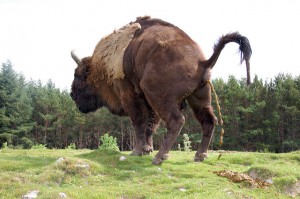Image: Flickr/Paul Stevenson
If the above image disturbs you, move along; this post is not for you! In this study, published this week in the journal Soft Matter (yes, seriously), scientists from the Georgia Institute of Technology report their detailed studies of the pooping habits of a wide variety of mammals. Using video recordings of the fecal extrusions and measuring the resulting turds, they deduce that “Despite the length of rectum ranging from 4 to 40 cm, mammals from cats to elephants defecate within a nearly constant duration of 12 ± 7 seconds (N=23). We rationalize this surprising trend by the model, which shows that feces slide along the large intestine by a layer of mucus, similar to a sled sliding through a chute. Larger animals have not only more feces but also thicker mucus layers, which facilitate their ejection.” If you are interested in pooping, be sure to check out the Supplementary Movies — we had no idea that Panda poop is green!
“Animals discharge feces within a range of sizes and shapes. Such variation has long been used to track animals as well as to diagnose illnesses in both humans and animals. However, the physics by which feces are discharged remain poorly understood. In this combined experimental and theoretical study, we investigate the defecation of mammals from cats to elephants using the dimensions of large intestines and feces, videography at Zoo Atlanta, cone-on-plate rheological measurements of feces and mucus, and a mathematical model of defecation. The diameter of feces is comparable to that of the rectum, but the length is double that of the rectum, indicating that not only the rectum but also the colon is a storage facility for feces. Despite the length of rectum ranging from 4 to 40 cm, mammals from cats to elephants defecate within a nearly constant duration of 12 ± 7 seconds (N=23). We rationalize this surprising trend by the model, which shows that feces slide along the large intestine by a layer of mucus, similar to a sled sliding through a chute. Larger animals have not only more feces but also thicker mucus layers, which facilitate their ejection. Our model accounts for the shorter and longer defecation times associated with diarrhea and constipation, respectively. This study may support clinicians’ use of non-invasive procedures such as defecation time in the diagnoses of ailments of the digestive system.”
Related content:
Rectal salami.
Accidental condom inhalation.
Scientists use dog sh*t to protect crops from hungry sheep.
